Delegates of the Republican Party of New Mexico (RPNM) gathered at the Hotel Albuquerque on Friday evening, 6 March, for their State Pre-Primary Nominating Convention which was held Saturday morning, March 7th. The convention is for candidates who seek statewide or congressional offices.
Only those candidates who have gathered signatures equal to 2% of their party's total votes cast in its previous gubernatorial primary may compete in the pre-primary convention. The New Mexico pre-primary convention law then requires those candidates for statewide offices and congressional seats to receive 20% of the delegate vote to be "certified" as convention-designated nominees for the primary.
The first thing we have to say is that the convention was very well run, efficient, on-time, with no glitches of any kind that we took note of.
.jpg) Steve Pearce started the whole thing off, which as state chairman was certainly appropriate. He
Steve Pearce started the whole thing off, which as state chairman was certainly appropriate. He 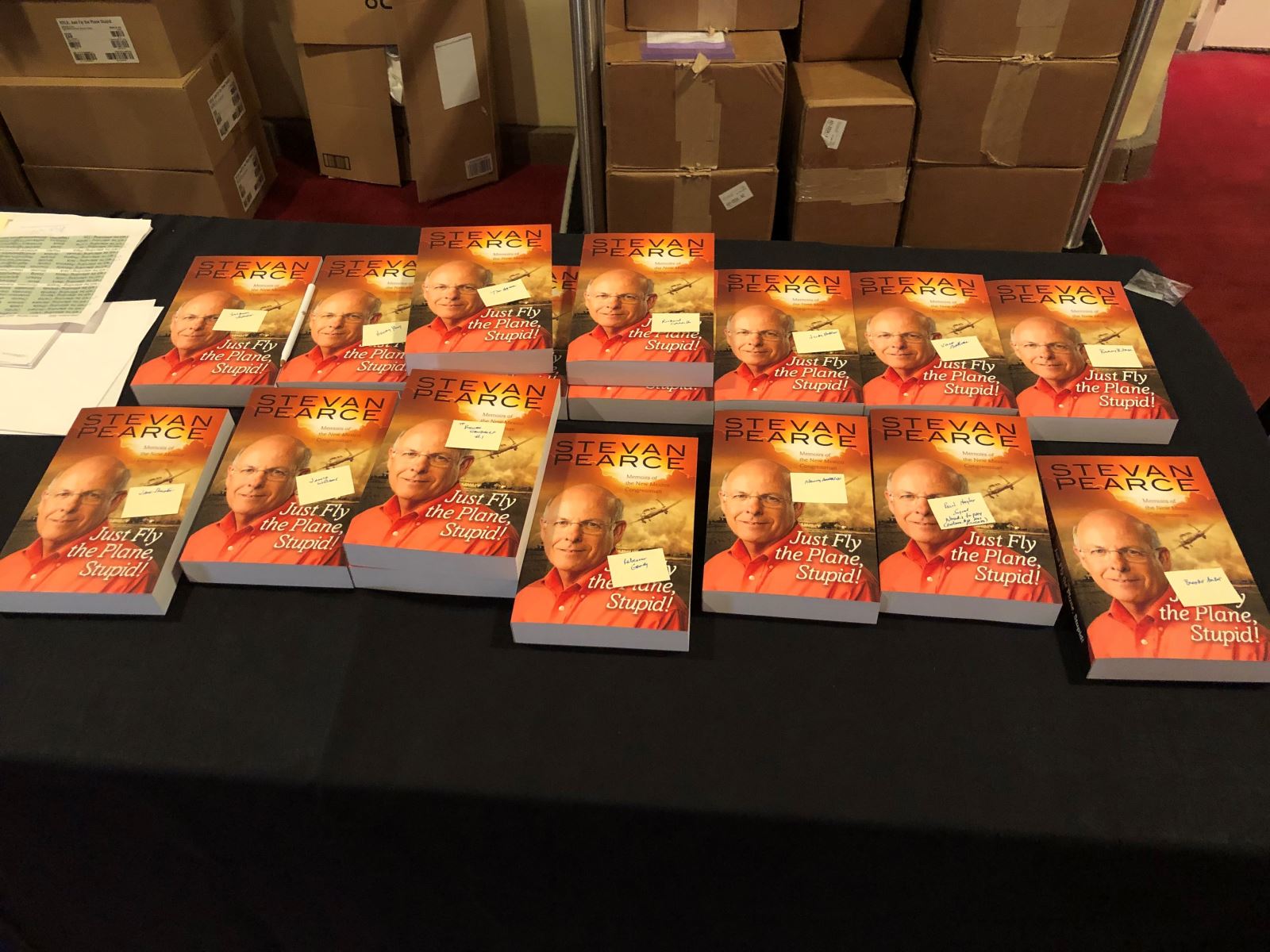 hawked his autobiography, which was on prominent display, though we never saw anyone buy one.
hawked his autobiography, which was on prominent display, though we never saw anyone buy one.
It's available in thrift stores in southeastern New Mexico for 25 to 50 cents, though to be fair, many many books are sold at that price, not just Pearce's. But Pearce did give a good, solid, rousing speech, which was fairly well-received, though certain sectors did not respond as we thought the theme merited.
Candidate Speeches and Results
Congressional District 1
.jpg) Michelle Garcia Holmes led off, making an okay speech with frequent referrals to notes, indicating some unfamiliarity with her message. She was well-received as the bulk of Albuquerque delegates present in their home town venue were in support of her candidacy.
Michelle Garcia Holmes led off, making an okay speech with frequent referrals to notes, indicating some unfamiliarity with her message. She was well-received as the bulk of Albuquerque delegates present in their home town venue were in support of her candidacy.
Brett Kokinadis delivered an okay speech as well, though he also had to constantly refer to notes and was not as well-prepared as others. His themes were generally not in sync with the views of the overall convention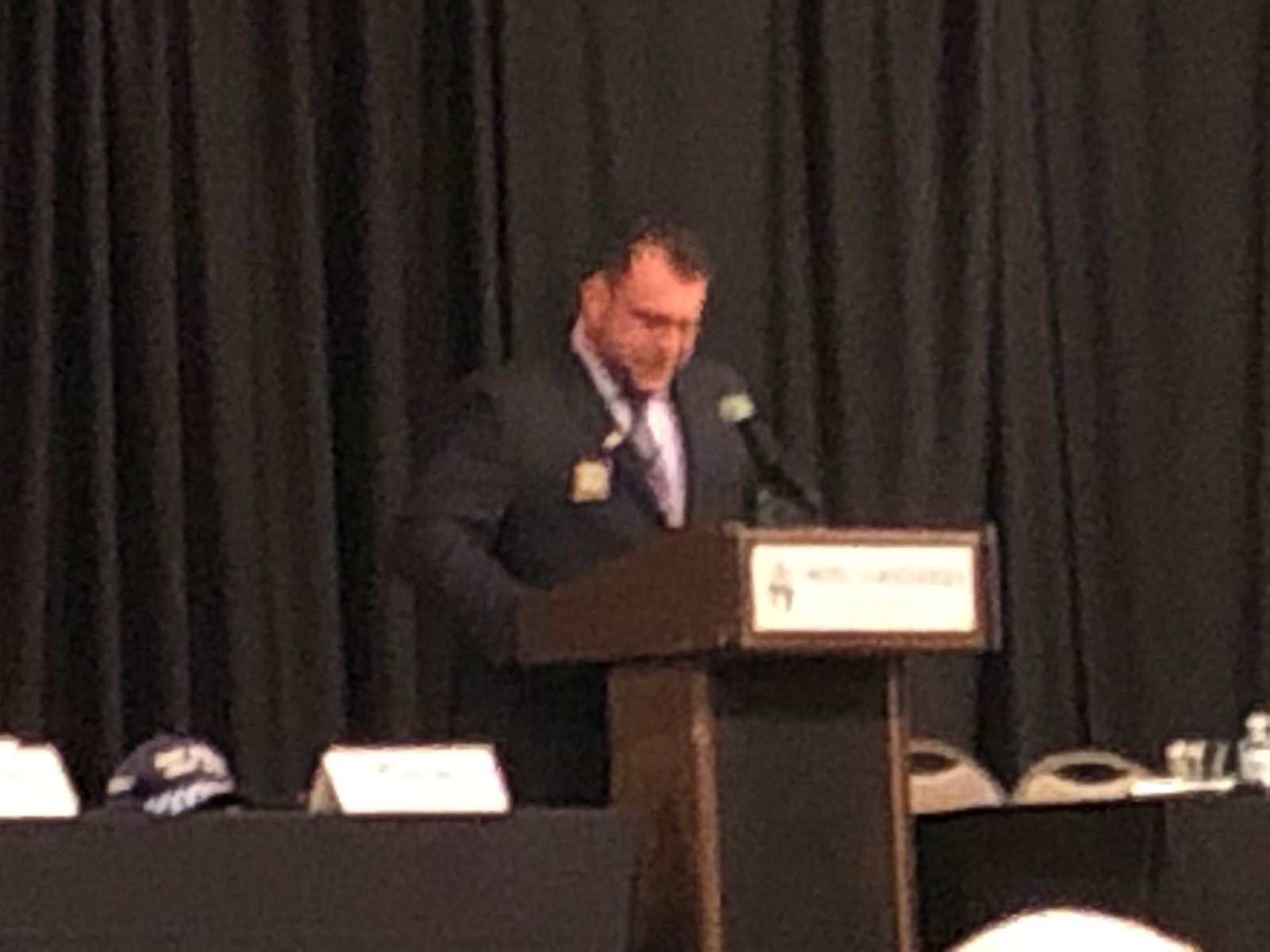 crowd. This was probably predictable, given that he's only been a Republican for five months and his views still by and large reflect his life-long Democrat leanings.
crowd. This was probably predictable, given that he's only been a Republican for five months and his views still by and large reflect his life-long Democrat leanings.
It's one thing to change parties—that happens all the time. But in most cases, the change is made because a person realizes that his or her current party does not match his or her actual worldview or political philosophy. It is not clear if this is the case with Kokinadis, or if he instead intends to lead the GOP to embrace new policy positions it doesn't currently hold.
Attendees also told us he was hurt by an abrupt switch from the CD3 primary to CD1 that they claimed had the appearance of opportunism rather than sincerity.
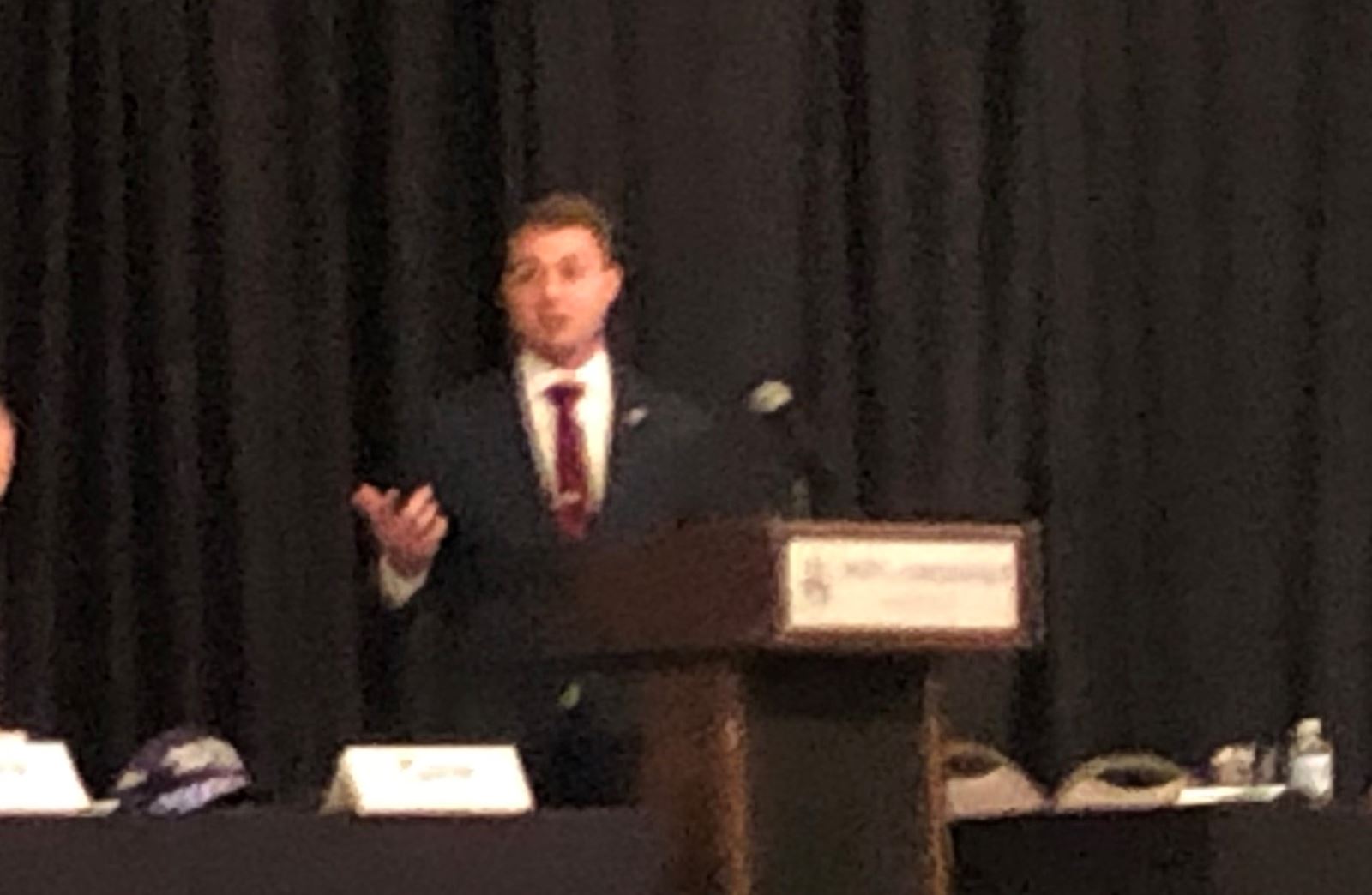 Jared Vander Dussen finished the three-candidate set by giving a well-prepared speech with no notes and he never looked down or anyplace else other than to his audience. He was one of two candidates to accomplish this (Yvette Herrell was the other). He made a generally very good impression.
Jared Vander Dussen finished the three-candidate set by giving a well-prepared speech with no notes and he never looked down or anyplace else other than to his audience. He was one of two candidates to accomplish this (Yvette Herrell was the other). He made a generally very good impression.
RESULT: Holmes 135 (63.4%) Vander Dussen 64 (30.3%) Kokinadis 14 (6.6%). Holmes won an impressive victory, with Vander Dussen coming through with a very respectable showing, and Kokinadis receiving very little support. By all accounts, it went about as expected, though some were surprised that Kokinadis did very very poorly, believing he had a real chance to reach 20%.
Congressional District 2
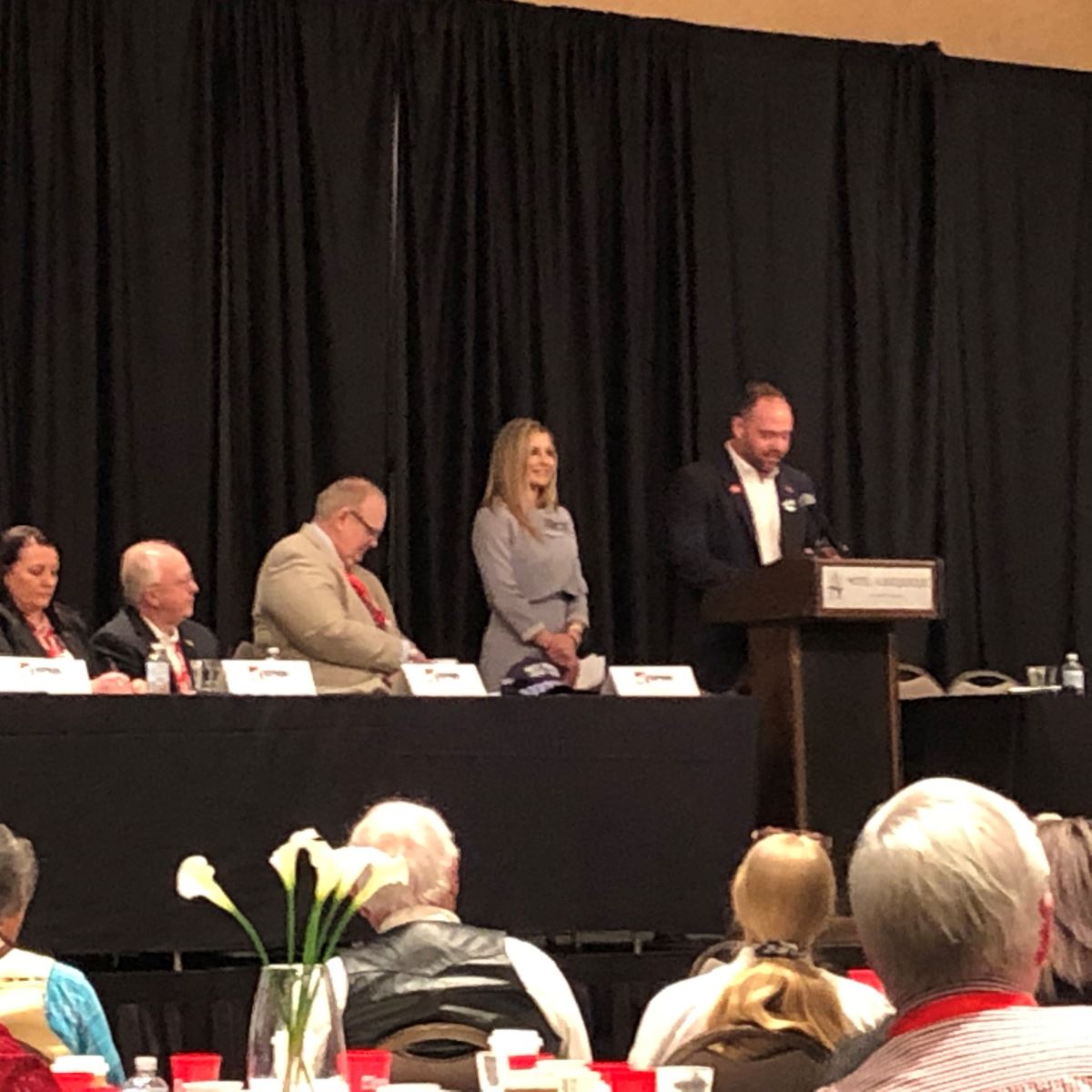 Claire Chase was introduced by her husband, and then gave a pretty good speech, with a certain degree of energy and was well received. It must be noted, however, that at the 3-minute 50-second mark, Chase's microphone was cut off. She is the only candidate who received this treatment, though others did go past the 3½-minute time limit.
Claire Chase was introduced by her husband, and then gave a pretty good speech, with a certain degree of energy and was well received. It must be noted, however, that at the 3-minute 50-second mark, Chase's microphone was cut off. She is the only candidate who received this treatment, though others did go past the 3½-minute time limit.
When that happened, Chase maintained her poise and reacted with grace, something the audience seemed to appreciate.
Yvette Herrell was introduced by Couy Griffin, who has built up a business enterprise called Cowboys for Trump* and has a certain following in the state. .jpg) Griffin gave a rousing, well-received speech, as did Herrell. In fact, it could be said that Herrell actually knocked it out of the park.
Griffin gave a rousing, well-received speech, as did Herrell. In fact, it could be said that Herrell actually knocked it out of the park.
She had clearly spent a lot of time rehearsing the speech—which is something every convention candidate should do, but few actually accomplish. It paid off, and she was probably the best-received candidate on that date.
However, it must be noted that Herrell went all the way to 3 minutes 54 seconds (four seconds longer than Chase) and her mike was not cut. (So there was non-uniform treatment of candidates in that respect.)
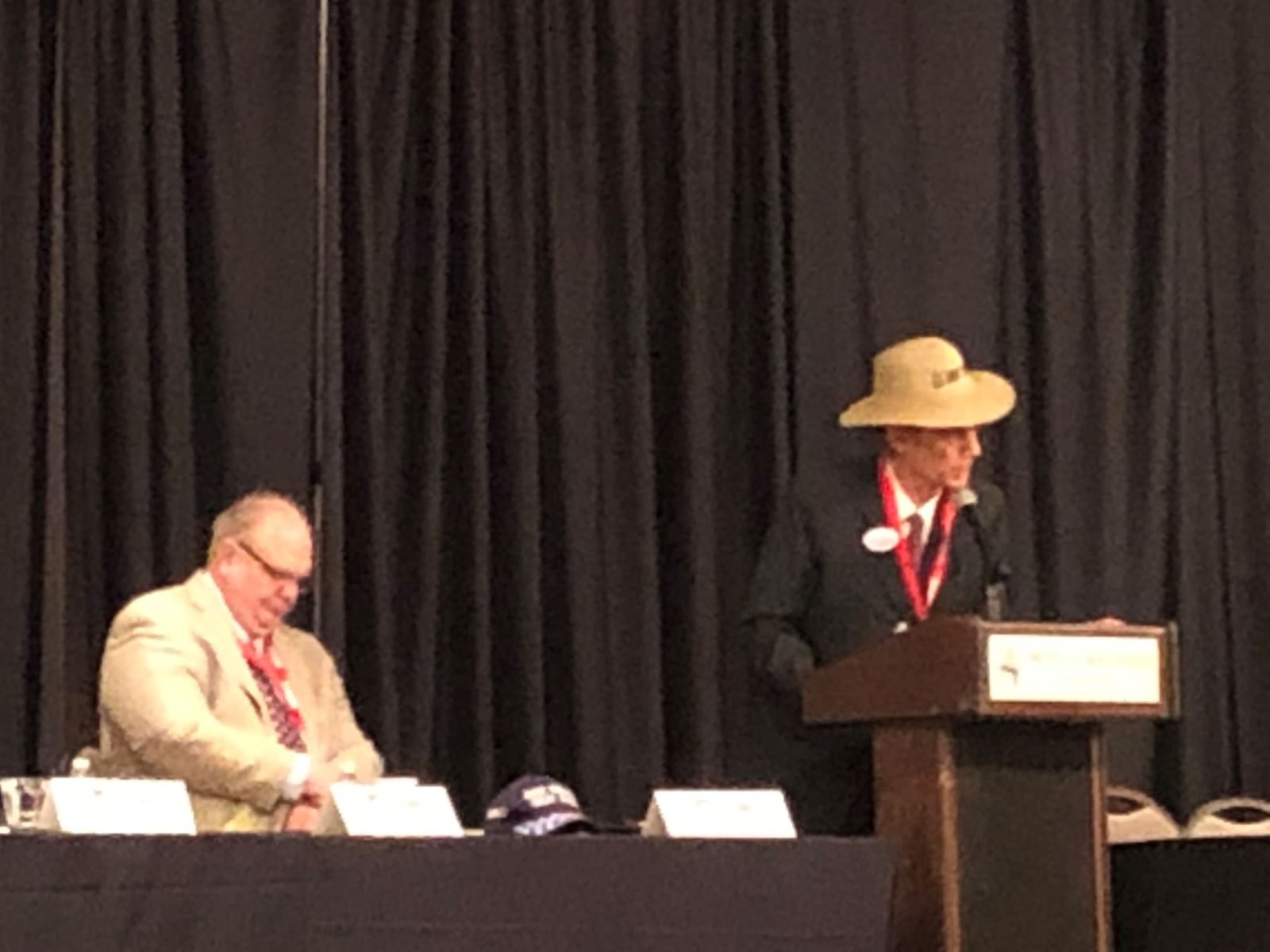 Chris Mathys showed up with a hat—something we believe is usually not a good look (with the possible exception of a Land Commissioner or County Sheriff candidate). It wasn't a cowboy hat, but some sort of odd, exotic style. He gave a reasonable speech, but not anything that would move the crowd.
Chris Mathys showed up with a hat—something we believe is usually not a good look (with the possible exception of a Land Commissioner or County Sheriff candidate). It wasn't a cowboy hat, but some sort of odd, exotic style. He gave a reasonable speech, but not anything that would move the crowd.
RESULT: Herrell 168 (66.1%) Chase 83 (32.7%) Mathys 3 (1.2%). While Herrell's victory was reasonably impressive, it was also very much expected, as Steve Pearce had led a contingent of about a hundred people in Lea County that took over their county convention and had secured at least 90% of the delegates there.
[NOTE: Though he has escaped notice thus far (probably because disadvantaged candidates do not wish to file a formal complaint against their own state chairman) Pearce has left himself open to being cited for violations of §1-19-1 of the New Mexico Election Code.]
Pearce has engaged in similar operations, in several contested primaries, but perhaps most noticeably in the CD2 race. His involvement—and the active, ongoing involvement of the RPNM on behalf of Herrell—has been so extensive that most observers were thinking that the effort to keep Chase from reaching the 20% threshold might be successful.
Given that context, Chase's showing exceeded most people's expectations and her campaign was clearly happy to emerge with convention designation. Mathys' showing was about as expected, though perhaps a higher single figure of total votes was expected.
Congressional District 3
Audra Lee Brown appeared in a cowboy hat and delivered a reasonable speech. She got some laughs from the crowd and developed a good rapport..jpg) We later learned from a close observer that the rationale for the hat was not the cowboy motif so favored by Gavin Clarkson et.al, but rather to obscure a rainbow-colored coif that might otherwise be viewed as off-putting. In any case, Brown's speech was pretty well delivered.
We later learned from a close observer that the rationale for the hat was not the cowboy motif so favored by Gavin Clarkson et.al, but rather to obscure a rainbow-colored coif that might otherwise be viewed as off-putting. In any case, Brown's speech was pretty well delivered.
.jpg) Karen Evette Bedonie, who is Navajo, brought a considerable entourage to the stage and made an appeal that was somewhat heavy on identity politics.
Karen Evette Bedonie, who is Navajo, brought a considerable entourage to the stage and made an appeal that was somewhat heavy on identity politics.
This is a somewhat risky tactic in conservative settings where the voters believe politics is about ideas and a candidate's stands on issues rather than overt appeals to demographic subgroups of the population. Bedonie did pretty well and seemed to make a connection with the crowd.
Anise Golden-Morper, newly back on the ballot and fresh off an easy victory over a poor ruling by the Secretary of State (who seems continuously power-hungry and overreaching) brought something of a defiant mood to the stage.
Because she is only 4' 6", the lectern had to be moved back and off to her right so she could be in full view of the convention audience. She displayed a lot of energy, but—perhaps understandably—devoted too much time to her court victory and not quite enough to the great national issues to which a congressional candidate should be attuned. Still, she made a solid impression overall.
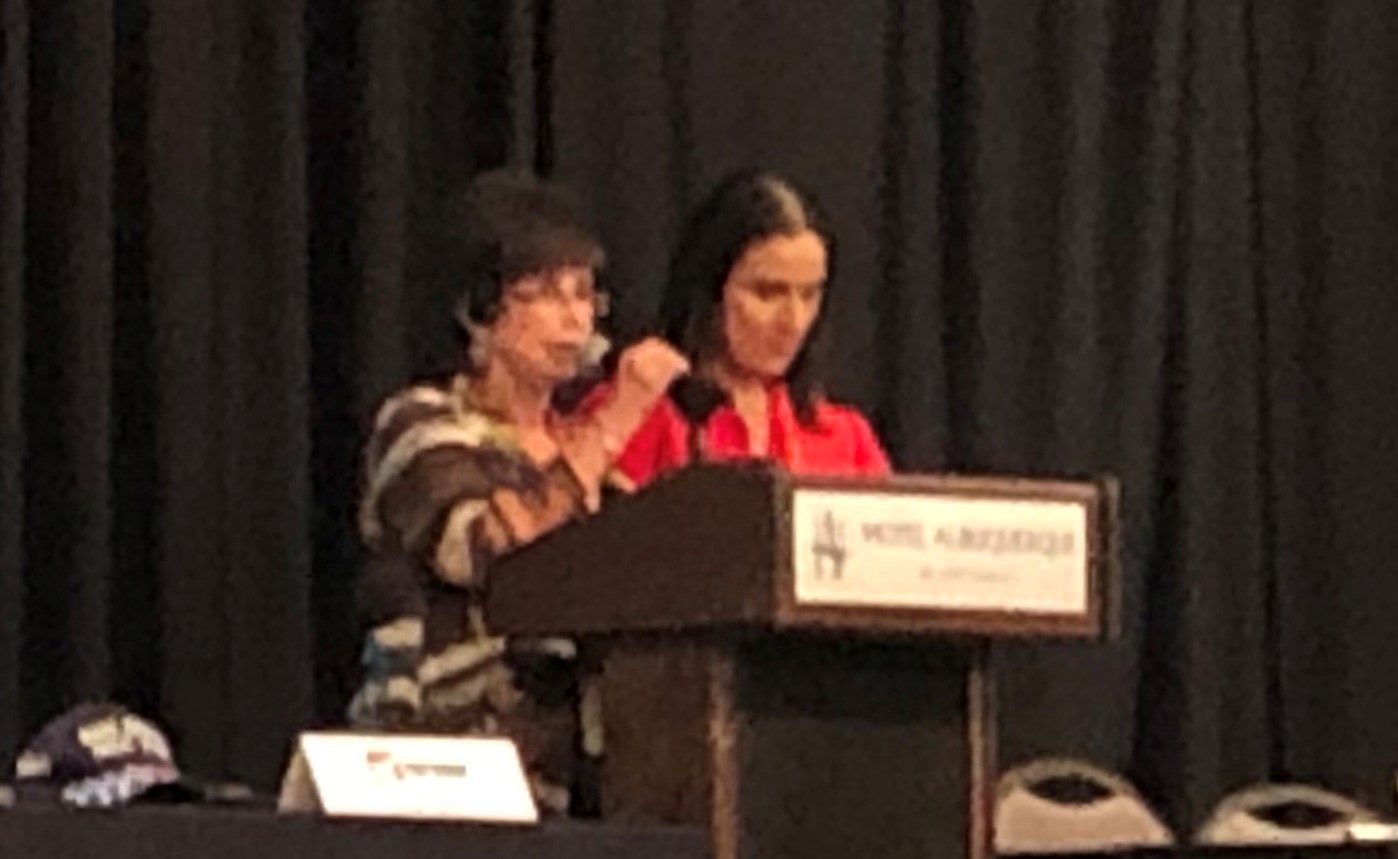 Alexis M. Johnson made what sounded like the best-outlined and maybe the best-scripted speech of the day (with the possible exception of Herrell's). Unfortunately, in the hubbub surrounding Golden-Morper's visibility, when the lectern was moved back into place, the microphone was left dangling to the right and down and away from the speaker. Either that or her nominating speaker left it in an awkward position.
Alexis M. Johnson made what sounded like the best-outlined and maybe the best-scripted speech of the day (with the possible exception of Herrell's). Unfortunately, in the hubbub surrounding Golden-Morper's visibility, when the lectern was moved back into place, the microphone was left dangling to the right and down and away from the speaker. Either that or her nominating speaker left it in an awkward position.
In any case, Johnson did not make an effort to ensure that she and her microphone were in sync. As a result, the volume of her voice ranged between very low to a light, mid-range level.
As she came in and out, it definitely appeared she was giving the right inflection and proper emphasis to have a desired effect, but much of that effect, if not most of it was missed, and therefore lost on the audience. The people right in front of her did react more strongly than most of the nearly 700 who had gathered in the room. It was an unfortunate turn of events for her..jpg)
Harry B. Montoya was introduced by former Congressman Bill Redmond, an experienced hand whose first move on the podium was to take control of the microphone with his hand and adjust it, and even holding it while he spoke.
We usually don't believe introductory speeches are the way to go (they take time away from the candidate, who, after all, is the subject on trial) but Redmond's recognition of the mike problem did a great deal for Montoya.
Montoya was also accompanied by an enormous entourage, one that included quite a few natives of northern pueblos. They appeared to be making it clear that Bedonie, whatever identity she may invoke, does not have a lock on the Native American vote. (It may be lost on some, but there exists a certain degree of, shall we say "disconnect" between Pueblos and the Diné—which reflects long-standing, somewhat uneasy relationships.)
Montoya made a good speech on his own and connected.
RESULT: Montoya 86 (35.6%) Bedonie 69 (30.9%) Golden-Morper 39 (17.5%) Johnson 25 (11.2%) Brown 4 (1.8%). Montoya's victory may have .jpg)
 caught some off-guard, as he has been attacked pretty strongly for being another recent convert.
caught some off-guard, as he has been attacked pretty strongly for being another recent convert.
He left the Democrat Party only 11 months ago, after more than 35 years a Democrat and having served two terms as a Democrat Santa Fe County Commissioner.
His opponents claim he switched only because the state Democratic Party told him he had no place to run as a pro-life candidate and was unwelcome as a potential congressional candidate. This did not seem to hurt him among convention-goers, though it may as the primary campaign continues.
Bedonie's operation is very well organized, and, according to most observers, is far and away the nastiest—and said to be in league with US Senate candidate Elisa Martinez, whose surrogates and spokespersons are also running an extremely nasty and overwhelmingly negative campaign, especially in social media.
Both of those candidates, who seem to be running as a team, may eventually face a backlash from primary voters disgusted with their social media operations.
Whether it has come about via negativity or some sort of true grassroots support, Bedonie clearly has a formidable organization. Golden-Morper was clearly upset with her showing and dropped out of the race within a few days. Audra Brown did the same, having garnered only 4 votes.
For her part, Alexis Johnson vowed to continue the campaign. As the candidate who probably comes off more eloquently conservative Republican than any of the remaining three in the race, Johnson may yet have a shot at catching hold.
U.S. Senate
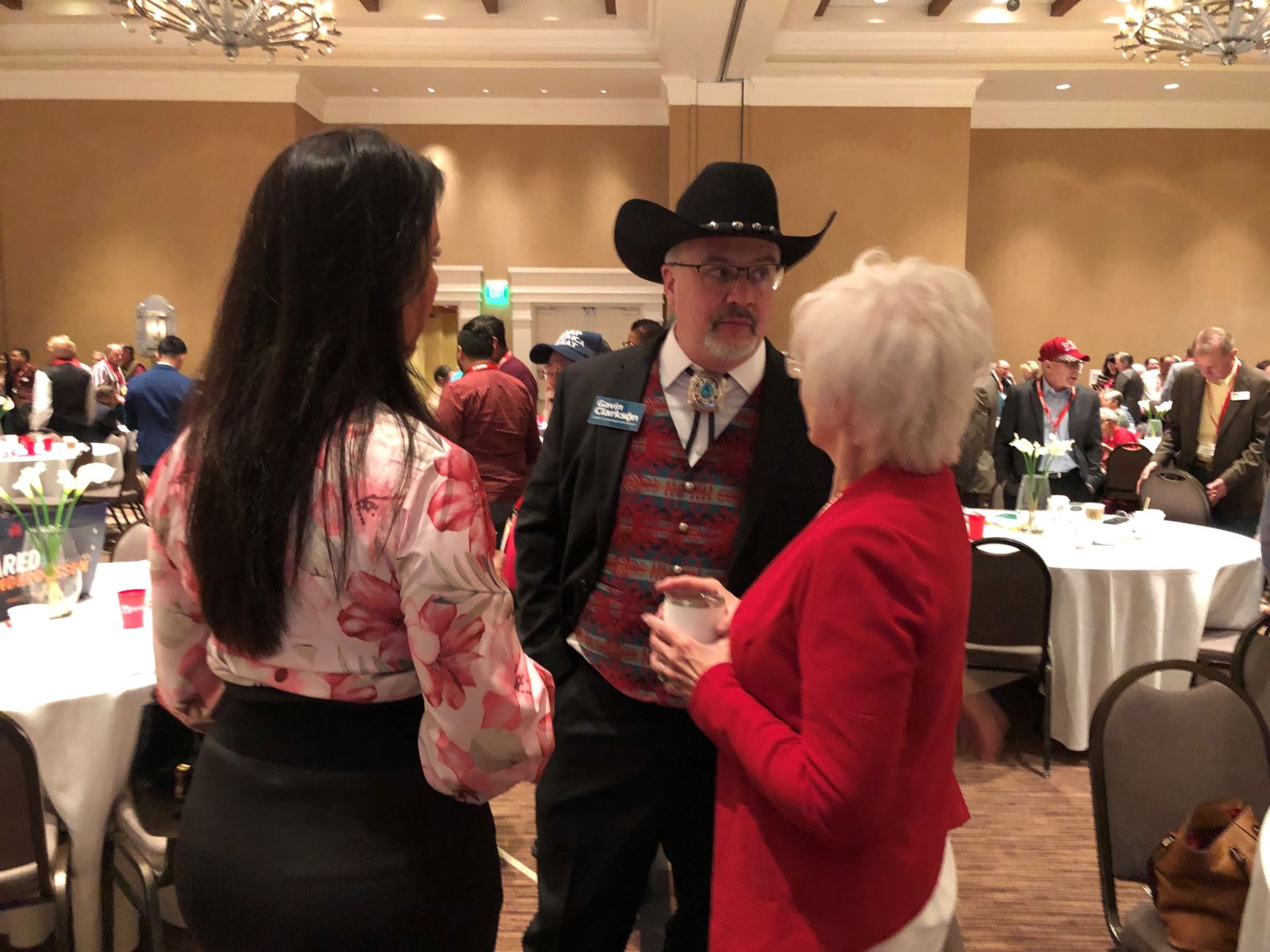 Gavin Clarkson led off the senate speeches attired in his semi-cowboy motif and did his usual good job of expounding on conservative Republican themes. He appeared to connect with the audience, most of whom have undoubtedly seen him around the state, as this is the third office he has sought over just the past 21 months.
Gavin Clarkson led off the senate speeches attired in his semi-cowboy motif and did his usual good job of expounding on conservative Republican themes. He appeared to connect with the audience, most of whom have undoubtedly seen him around the state, as this is the third office he has sought over just the past 21 months.
Elisa Martinez followed with a well-delivered speech, which connected with a built-in very receptive 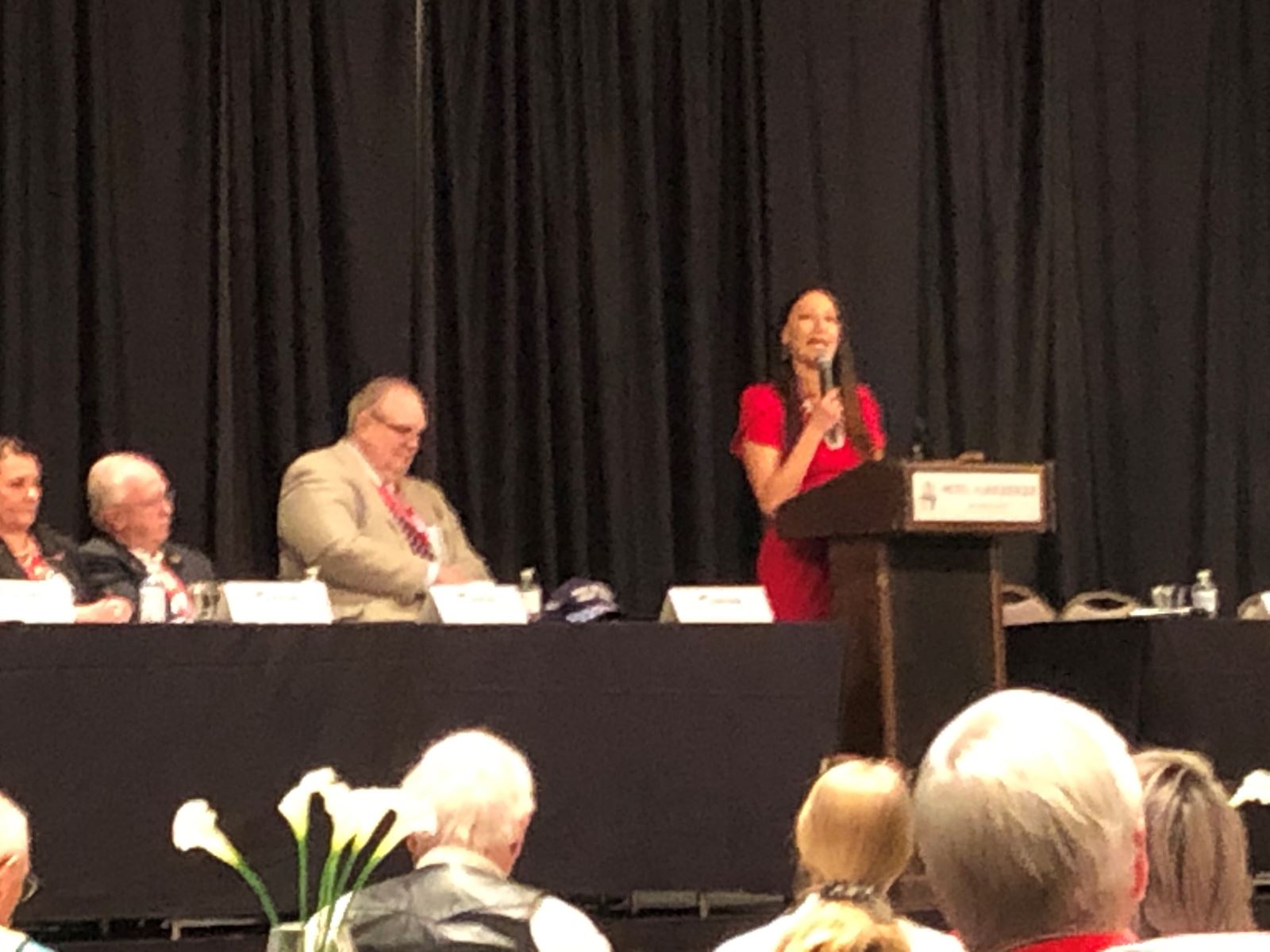 audience. As the former executive director of New Mexico Alliance for Life, she had an organizational advantage that allowed her to elect about a hundred members of that pro-life organization as delegates, leading to a real boost in enthusiasm for every part of her speech.
audience. As the former executive director of New Mexico Alliance for Life, she had an organizational advantage that allowed her to elect about a hundred members of that pro-life organization as delegates, leading to a real boost in enthusiasm for every part of her speech.
Martinez is Navajo, but emphasizes that she is also Hispanic, and she, much like Bedonie, made a very real identity-politics pitch. Again, this is a risky approach in a universe of voters who view identity politics with skepticism if not outright intellectual disdain.
Though to be fair, Martinez probably touched on more issues that resonate with conservative audiences than did Bedonie. Needless to say, she did well with the convention crowd.
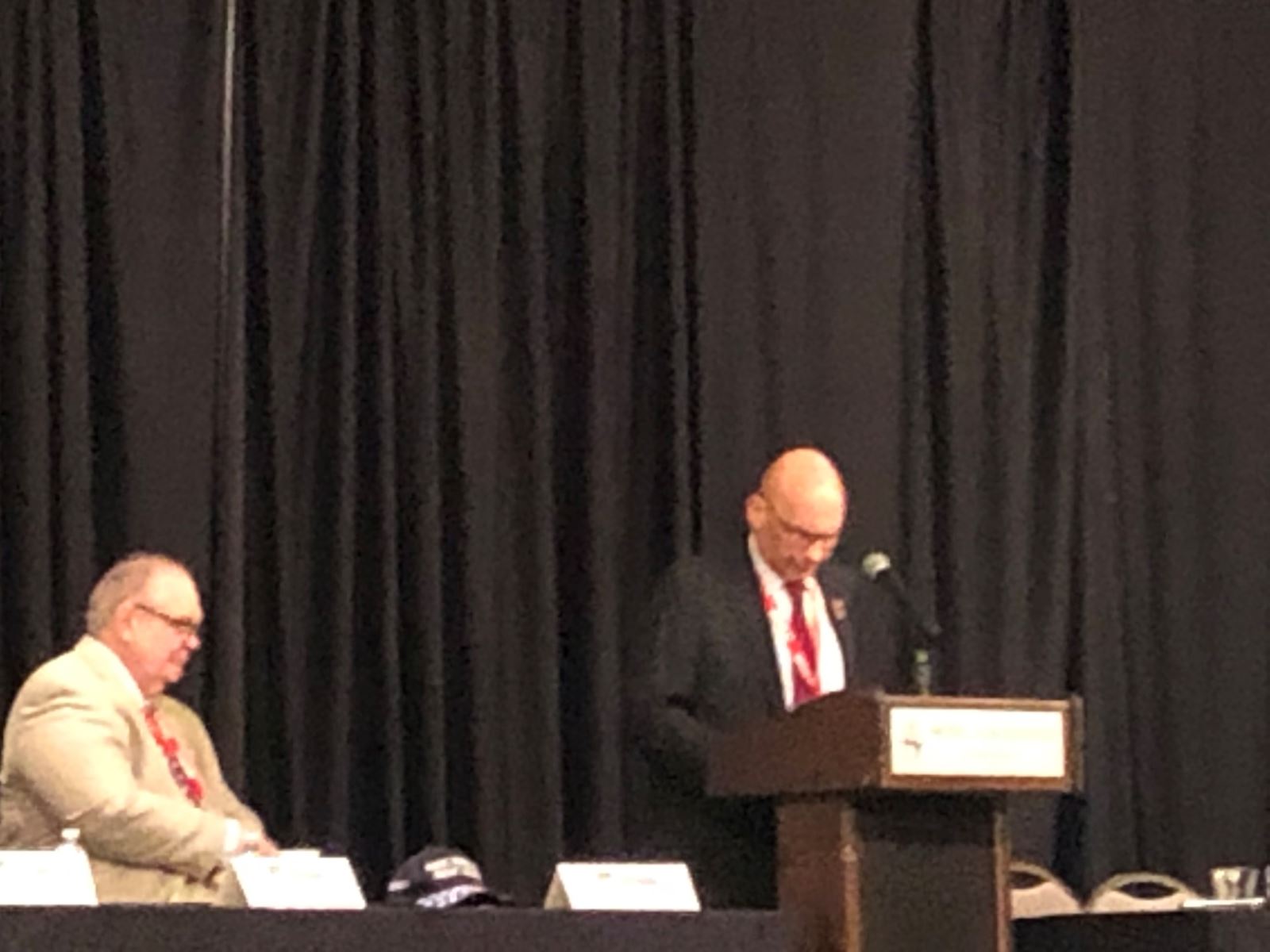 Mick Rich, who is clearly one of the nicest people to ever run for office anywhere, simply did not come across as someone who had his full heart and soul in this race. He read most of his speech, which is almost inexplicable for someone who is running for the same office for three years.
Mick Rich, who is clearly one of the nicest people to ever run for office anywhere, simply did not come across as someone who had his full heart and soul in this race. He read most of his speech, which is almost inexplicable for someone who is running for the same office for three years.
.jpg) Mark Ronchetti came through with a burst of enthusiasm that seemed to hit home with at least a portion of the convention crowd. He seemed to elicit a more increasing welcoming and friendly response as his speech went on.
Mark Ronchetti came through with a burst of enthusiasm that seemed to hit home with at least a portion of the convention crowd. He seemed to elicit a more increasing welcoming and friendly response as his speech went on.
Ronchetti has been the principal, if not the only target of the relentlessly vicious attacks by the Elisa Martinez social media operation. So it was not a surprise that it appeared that a large segment of the attendees had come in with a skeptical, if not negative, appraisal of his candidacy.
However, Ronchetti's enthusiasm and well-delivered, well-crafted speech seemed to win over a significant portion of that skeptical element.
Louie Sanchez made a good speech, highlighting his entrepreneurial talents and business success. He found a receptive audience as it appeared he had a lot of committed delegates who were big fans, a phenomenon we had noticed in various locations around the state. This was impressive in that we had never heard of him till his announcement earlier this year.
RESULT: Martinez 241 (34.9%) Ronchetti 198 (28.7%) Sanchez 113 (16.4%) Rich 72 (10.4%) Clarkson 66 (9.6%). Martinez's win was widely 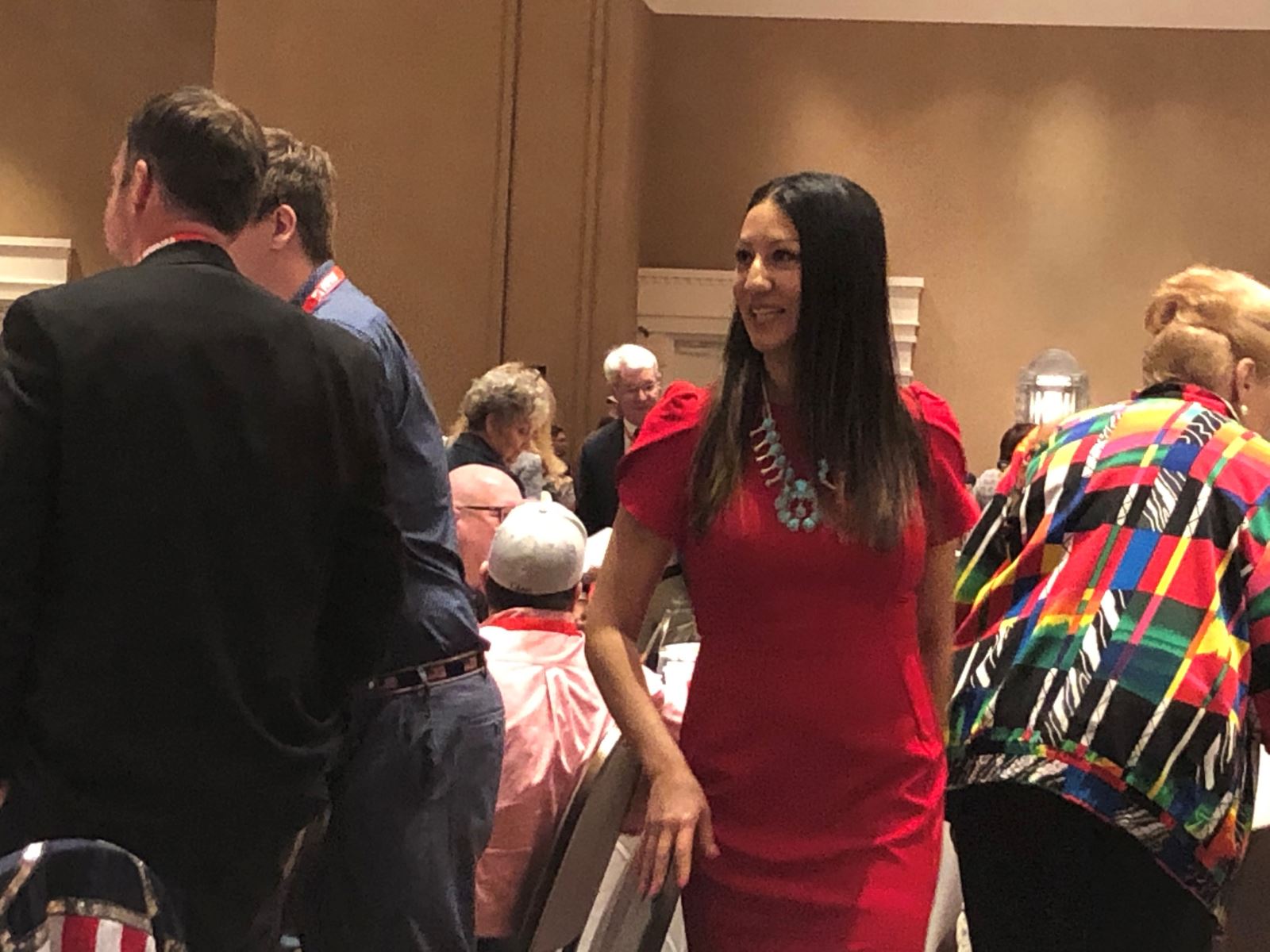 expected as she had a built-in base of about a hundred votes due to her very early start nearly six months ago and the hard work planning for the convention and rounding up the Alliance for Life members.
expected as she had a built-in base of about a hundred votes due to her very early start nearly six months ago and the hard work planning for the convention and rounding up the Alliance for Life members.
The surprise for almost everyone, including us, had to be Ronchetti. He had only recently entered the race and had done relatively little for this meeting, knowing that no matter what happened he had over 10,000 signatures and therefore did not have to worry about reaching the 20% threshold.
As a result he apparently spent nothing for the convention: no hospitality suite, no ads, no visible effort at all. Yet he surged very strongly, probably based on how he came across. It can even be argued that if only the persuadable delegates are considered, Ronchetti actually beat Martinez something like 190 to 140, pretty impressive.
Rich seemed somewhat despondent at the surprising result, and dropped out of the race. Clarkson's showing has to be considered unimpressive given his continuous campaign for three offices that has now lasted some 2½ years. However, he vowed to soldier on.
Another real surprise was Sanchez's inability to reach the 20% threshold, considering his extremely loyal base of support that had quickly emerged and his clear standing and reputation in the business community. Surprisingly, he dropped out as well. We are told that his lucrative business interests are more or less a "hands-on" requirement for him and that he concluded that he cannot really conduct the kind of campaign he needs to do while simultaneously giving the personal attention his enterprises require.
* The organization does, however, face serious questions involving its role in advocating the election of selected candidates, and whether or not it is filing proper campaign finance reports.)
Email us (at nmpj@dfn.com) with your feedback, comments, questions, and ideas.
Intelligent Political Discourse—for the Thoughtful New Mexican
.jpg)
